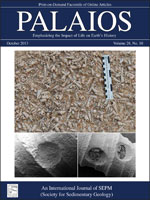A thin interval of bioturbated, fossiliferous mudstone within the middle portion of the Upper Pennsylvanian Barnsdall Formation crops out near Copan, northeastern Oklahoma. Representing slow background sedimentation in an oxygenated distal shelf setting, this exposure has yielded an exceptionally diverse and well-preserved crinoid fauna consisting of over 1200 articulated or partially articulated specimens. The interval is also characterized by abundant siderite concretions, present as four morphologies. Large concretions without a distinct skeletal nucleus are located in thin horizons containing abundant articulated crinoids; these indicate sediment starvation on the shelf. Also in these thin, crinoid-bearing units are extremely localized siderite concretions precipitated around sites where soft tissues would have been volumetrically more abundant within large macrofossils, notably tegmina and proximal arms of articulated crinoids, indicating extremely rapid burial events that episodically punctuated the sediment-starved conditions. Small concretions, generally <60 mm in diameter and commonly precipitated around endobenthic-fossil nuclei, are located in thicker units with few articulated crinoids. These indicate higher sedimentation rates and thicker individual burial events. Sideritized large-diameter burrows with sharply defined walls indicate firmer substrates created by minor erosive events. These are located in the thicker units alongside the smaller concretions and indicate higher-energy storm events than those represented in the thinner, crinoid-bearing units. Collectively, the evidence provided by siderite concretion morphologies and their relationships to macrofossil preservation demonstrate that the Copan crinoid Lagerstätte formed through periods of sediment starvation occasionally interrupted by distal storm events. These periods alternated with intervals of increased sedimentation and more violent storms.
How to translate text using browser tools
1 October 2013
SIDERITE CONCRETIONS IN THE COPAN CRINOID LAGERSTÄTTE (UPPER PENNSYLVANIAN, OKLAHOMA): IMPLICATIONS FOR INTERPRETING TAPHONOMIC AND DEPOSITIONAL PROCESSES IN MUDSTONE SUCCESSIONS
JAMES R. THOMKA,
RONALD D. LEWIS
ACCESS THE FULL ARTICLE
It is not available for individual sale.
This article is only available to subscribers.
It is not available for individual sale.
It is not available for individual sale.

PALAIOS
Vol. 28 • No. 10
October 2013
Vol. 28 • No. 10
October 2013




